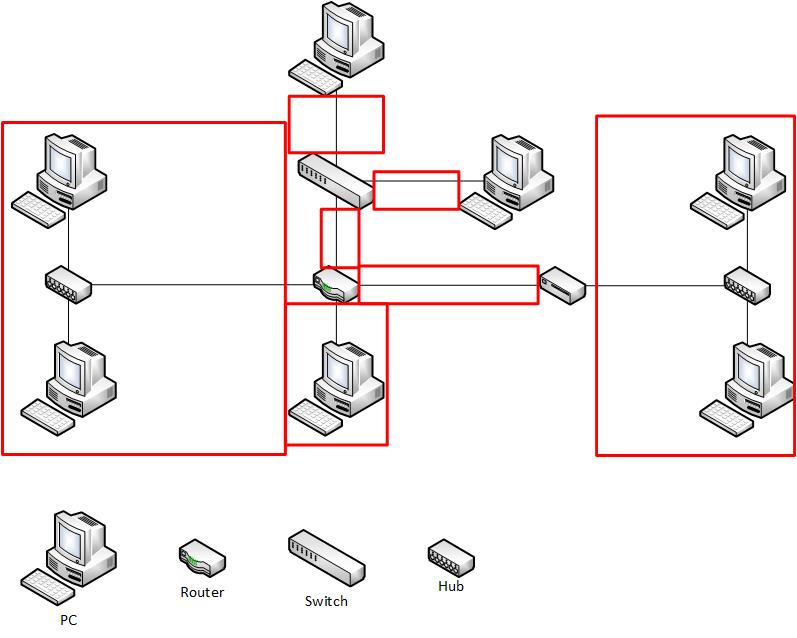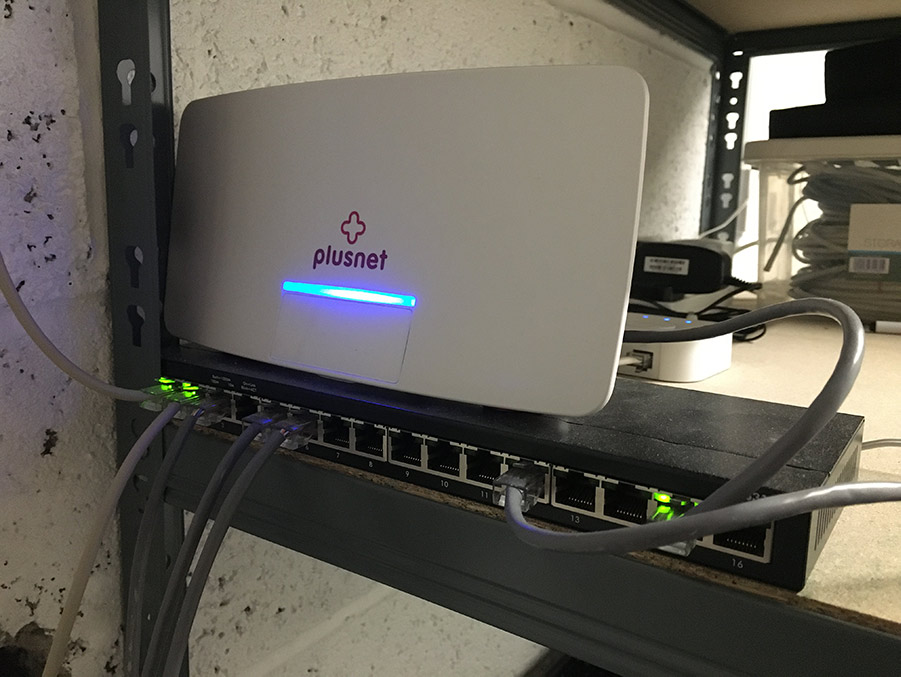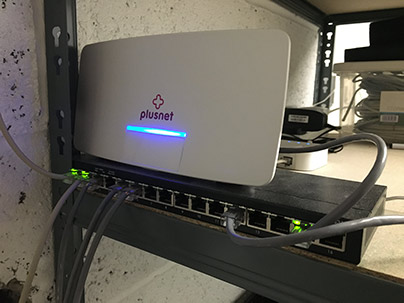Affiliate Disclosure: As an Amazon Associate I earn from qualifying purchases.
Wi-Fi is often considered to be the most convenient method of connecting a home network; it is usually quick and easy to set up and doesn’t require any additional wires trailing around your home. This got me thinking as to whether a network switch can be connected to a Wi-Fi network.
Network switches cannot connect to a Wi-Fi network or allow devices to connect to it wirelessly. The closest concept to a wireless switch is a signal booster or repeater, but these are considered to be hubs rather than switches.
I did some research into why wireless network switches don’t yet exist and what some of the alternatives are if you wanted to incorporate a network switch into your wireless setup.
Why Don’t Wireless Switches Exist?
Network switches are designed in such a way to take a signal in from a particular port and then rebroadcast it out on a specific port that it knows has previously had the device expecting to receive the signal connected to it.
Should this port not have anything plugged in, or a different device is connected, the switch will rebroadcast the signal across all the ports until it can find the recipient for the signal.
A hub works slightly differently in that it is always broadcasting across all of the ports.
Wireless networks don’t have an equivalent of how wired ports work and instead work more similarly to a hub.
Previously, you would have needed an additional device to sit in the middle of a network that is responsible for keeping an eye out for signals on a network segment that were intended for the other segment and then rebroadcasting the signal back and forth between the two.
This device is what you and I refer to as a router.
And this is actually how a router still works today. It takes the signal from WAN (wide area network), LAN (local area network), and WLAN (wireless local area network) networks and passes it on as necessary.
Routers were aware of gateways and protocol addresses, amongst other things, and therefore sat at a higher level than switches as they were considered to be more intelligent, more capable devices.
Another reason for wireless network switches not existing comes down to switches generally having one “wire”. This is referred to as the space, for lack of a better word, between the devices that are part of a network.
All of the devices share the same “space” so only one of them will send a packet of data at a time to mitigate the chances of there being a collision.
With wireless, you can have multiple “wires” by using several different sets of distinct radio frequencies, which allows different devices to communicate with each other at the same time when they are running on different frequencies.
It is for this reason that you will find a range of different frequencies within each wireless standard. You could be using one frequency, or channel, whilst your neighbor uses a different one, so your devices don’t interfere with each other.
There are some wireless access point protocols that allow different devices to use different frequencies whilst remaining connected to the same network, but we won’t go into that here.
If you only have only a small number of devices and there are no other local networks using the same frequency ranges, you won’t get one collision domain per device like you would if you were using a wired network switch.
Instead, you would get just the one collision domain per frequency range being used.
What Is a Collision Domain?
You may now be wondering what on earth a collision domain is.
Well, it is a term that is used to describe the part of a network where there is a chance that packet collisions can occur.
Packet collisions occur when two devices within a shared network segment are sending packets at exactly the same time. These packets must be removed and resent which in turns reduces the efficiency of the entire network.
The collisions can occur more often in networks that make use of hubs because all devices connected to the hub belong to the same collision domain.
Total network bandwidth is shared amongst all of the connected devices, and only one device is able to transmit data at a time whilst all the other devices must be listening on the network to avoid packet collisions.
Switches, routers and bridges work differently as each port belongs to a separate collision domain.
The main benefit to this is that possibility of packet collisions is removed completely, and each connected device is able to use what is known as full duplex. This allows you to get the most out of your devices by doubling the maximum data capacity.

The above diagram shows a network that makes use of hubs, a bridge, a switch, and a router. The different collision domains are outlined in red.
As you can see, the devices that connect to the hub belong to the same collision domain whereas each port on the bridge, router, or switch has its own separate collision domain.
The Difference Between Hubs, Switches, and Routers
Back in the day, all devices connected to the same wire were required to take it in turns to send data packets. There where various schemes in place to try and manage this, but collisions would occur where two devices try and use the wire to send data at the same time.
Hubs
Hubs essentially use the same arrangement and share the same wire; they are just more convenient to connect several devices to. There is still the single collision domain so only one device is able to send packets at a time.
Some hubs will have a small buffer to provide a better way of handling collisions than the devices themselves are able to, but the problem of having a single collision domain still exists as the hub doesn’t selectively send packets. Every packet will still be sent to all of the connected devices.
Switches
Switches are much more intelligent than hubs.
A switch will know which device is connected to which port and so can send packets to just the device that needs it and not every connected device like a hub would.
As a result, you only have one collision domain per connected device. Unlike with a hub, the throughput of the network does not degrade as more devices are connected and try to talk to each other at the same time.
Switching Hubs
Switching hubs, as you can probably tell from the name, are a hybrid of a hub and a switch.
They exist primarily because, with a hub, each connected device must be communicating using the same protocol and speed.
As an example, a 10/100 Mbps switching hub would essentially be two hubs contained within a single unit. One hub would operate at 10 Mbps with the other running at 100 Mbps. In between the two hubs would be a two port switch or router.
The more basic switching hubs previously had different ports for the different speeds that they supported, but most these days are intelligent enough to use the right protocol and speed regardless of the port that is plugged into, depending on the device that is connected.
Something worth bearing in mind is that switching hubs still only have the single collision domain.
Routers
A router is able to connect two network routes whilst keeping them as separate collision domains.
Regardless of whether two wired networks are using the same protocol, a combination of a wired network and a wireless one, or are using different protocols, the collision domains will always be kept separate.
By definition, a standard wireless access point is actually a router, whilst also acting as a network switch when it has multiple Ethernet ports built into it.

What About Signal Boosters or Repeaters?
The closest concept to a wireless switch is a signal booster or repeater. You can probably tell what they do just by their name.
They don’t get referred to as switches though because they are technically hubs. Hubs themselves can actually get referred to as repeaters when they only join two network segments.
Wi-Fi can’t selectively broadcast to only one port because everything is on a single port, making it more like a hub than a switch.
Even though a signal booster or repeater is the closest thing you will find to a wireless network switch, they are most definitely not a switch.
It’s also pretty rare to see this sort of setup outside of exceptional circumstances as it is widely considered better to extend a network using a wired connection and wireless access points that share the same SSID (service set identifier).
What Is the Solution?
If wireless network switches don’t exist, what are the alternatives?
The best solution really comes down to what you are looking to achieve with your home network and the equipment you have available.
If you have a spare router lying around, you could use it as a network switch. Although routers typically don’t have many Ethernet ports on the back, they at least have a few for you to make use of. I have a dedicated article on how to set up two routers on the same network if this setup sounds interesting to you.
Another option would be to invest in a wireless access point. It would be connected directly into your existing router using an Ethernet cable and would help improve the overall wireless coverage within your home. Some have an extra Ethernet port or two as well should you want to use a wired connection.
The third option is to set up powerline networking. Powerline adapters make use of the existing electrical wiring found within the walls of your home to transmit data. Simply plug the powerline adapter into an available wall outlet and you’ll have an Ethernet port ready and waiting to be used.
It is possible to plug a network switch into a powerline adapter to expand the number of Ethernet ports available to you, making it as close as you can get to a wireless network switch. The downside with this is that all of the devices connected to the switch will share the powerline connection to the network, so your bandwidth for all devices will be limited to the speed of that connection.
Final Thoughts
To conclude, you cannot connect a network switch to a Wi-Fi network; they are simply not designed to work this way and operate in very differently to wireless signals.
That being said, you still have a few options that make use of both Ethernet and wireless such as connecting up a wireless access point or plugging your network switch into a powerline adapter.
If you found this article useful, be sure to check out some of my others where we talk more about network switches, Wi-Fi and a host of other home network related topics.
